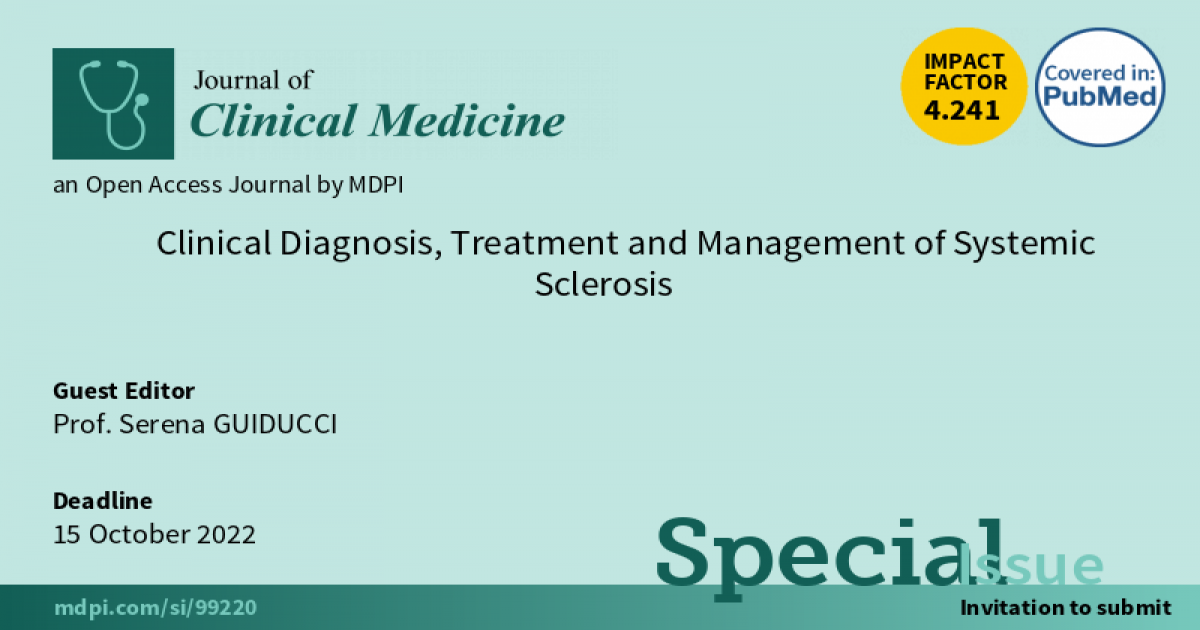Clinical Diagnosis, Treatment and Management of Systemic Sclerosis
A special issue of Journal of Clinical Medicine (ISSN 2077-0383). This special issue belongs to the section "Immunology & Rheumatology".
Deadline for manuscript submissions: closed (15 October 2022) | Viewed by 5223

Special Issue Editor
Interests: autoimmune diseases; systemic sclerosis; interstitial lung disease; rheumatoid arthritis; inflammatory rheumatic diseases
Special Issues, Collections and Topics in MDPI journals
Special Issue Information
Dear Colleagues,
Systemic Sclerosis (SSc) is a chronic connective tissue disease characterized by microvascular alteration, the activation of autoimmunity with the production of specific auto-antibodies, and the fibrosis of skin and internal organs. In the last decade, many efforts have been made in the identification of patients in the early phase of the disease, and a breakthrough in the management of SSc was made with the 2013 ACR/EULAR classification criteria, which allowed the identification of SSc patients in the early phase of the disease. Organ involvement may be present from the early phases, often being subclinical and underdiagnosed. Pulmonary involvement and pulmonary arterial hypertension represent the most feared complications and the main causes of SSc-related death. Digital ulcers together with gastrointestinal involvement have severe impacts on the quality of life of SSc patients. SSc represents a heavy socio-economic burden and a challenge for rheumatology due to its high clinical heterogeneity.
Prof. Serena GUIDUCCI
Guest Editor
Manuscript Submission Information
Manuscripts should be submitted online at www.mdpi.com by registering and logging in to this website. Once you are registered, click here to go to the submission form. Manuscripts can be submitted until the deadline. All submissions that pass pre-check are peer-reviewed. Accepted papers will be published continuously in the journal (as soon as accepted) and will be listed together on the special issue website. Research articles, review articles as well as short communications are invited. For planned papers, a title and short abstract (about 100 words) can be sent to the Editorial Office for announcement on this website.
Submitted manuscripts should not have been published previously, nor be under consideration for publication elsewhere (except conference proceedings papers). All manuscripts are thoroughly refereed through a single-blind peer-review process. A guide for authors and other relevant information for submission of manuscripts is available on the Instructions for Authors page. Journal of Clinical Medicine is an international peer-reviewed open access semimonthly journal published by MDPI.
Please visit the Instructions for Authors page before submitting a manuscript. The Article Processing Charge (APC) for publication in this open access journal is 2600 CHF (Swiss Francs). Submitted papers should be well formatted and use good English. Authors may use MDPI's English editing service prior to publication or during author revisions.
Keywords
- Systemic sclerosis
- Vascular damage
- Heart involvement
- Kidney involvement
- Gastrointestinal involvement
- Interstitial lung disease
- SSc-specific autoantibodies
- Clinical heterogeneity
- Digital ulcers
- Classification criteria
Benefits of Publishing in a Special Issue
- Ease of navigation: Grouping papers by topic helps scholars navigate broad scope journals more efficiently.
- Greater discoverability: Special Issues support the reach and impact of scientific research. Articles in Special Issues are more discoverable and cited more frequently.
- Expansion of research network: Special Issues facilitate connections among authors, fostering scientific collaborations.
- External promotion: Articles in Special Issues are often promoted through the journal's social media, increasing their visibility.
- Reprint: MDPI Books provides the opportunity to republish successful Special Issues in book format, both online and in print.
Further information on MDPI's Special Issue policies can be found here.






